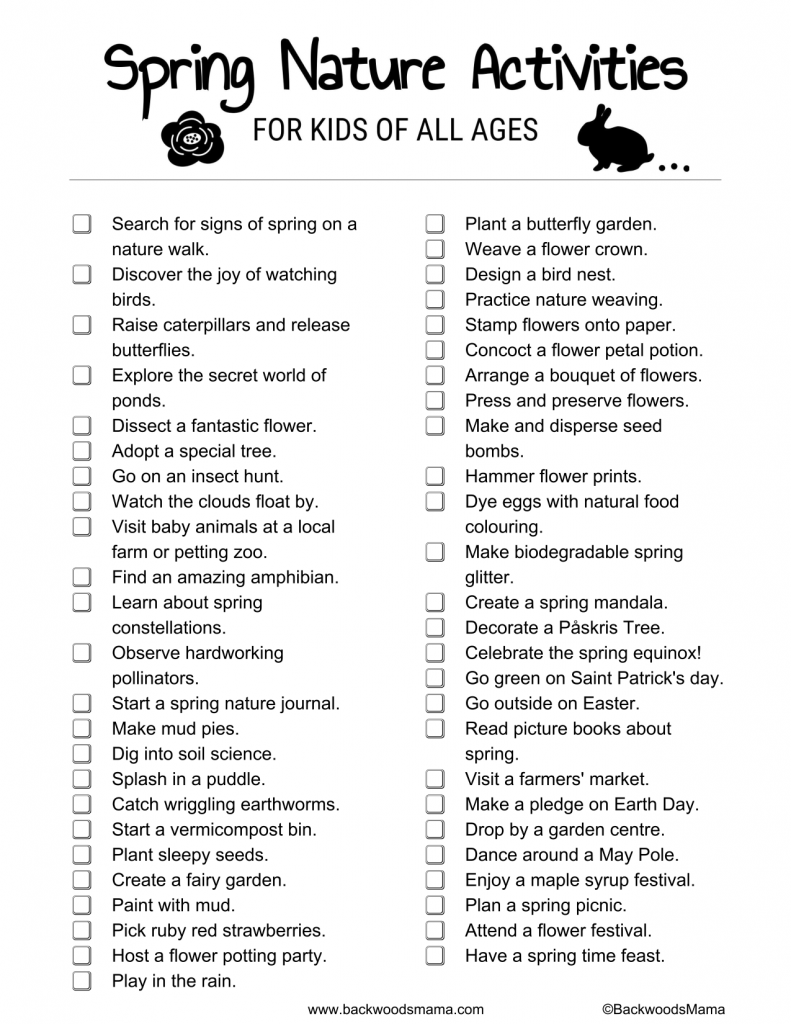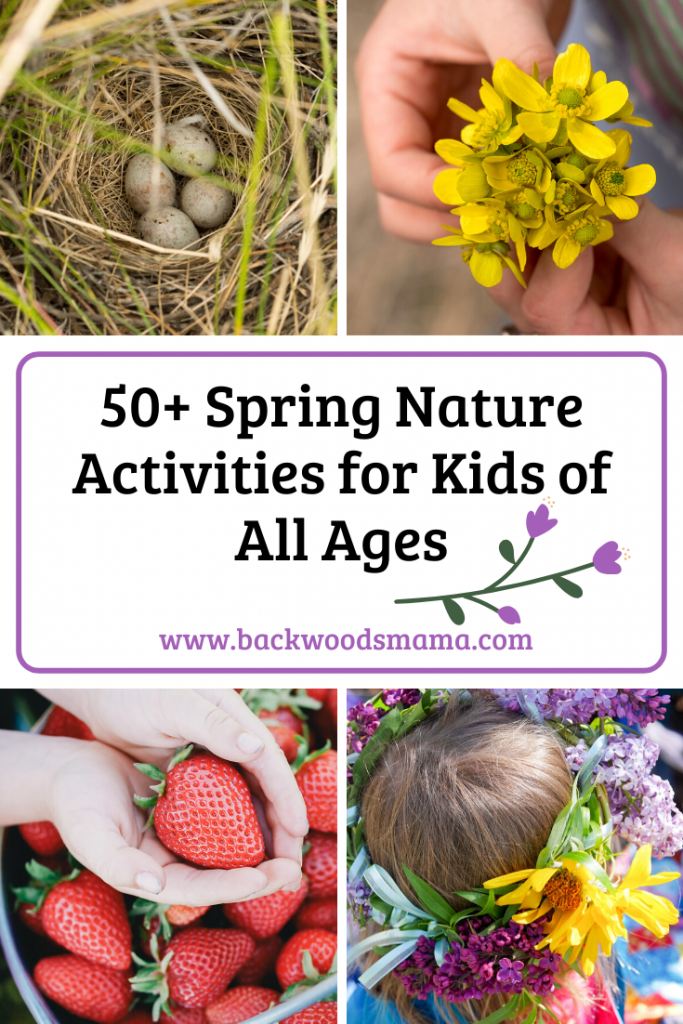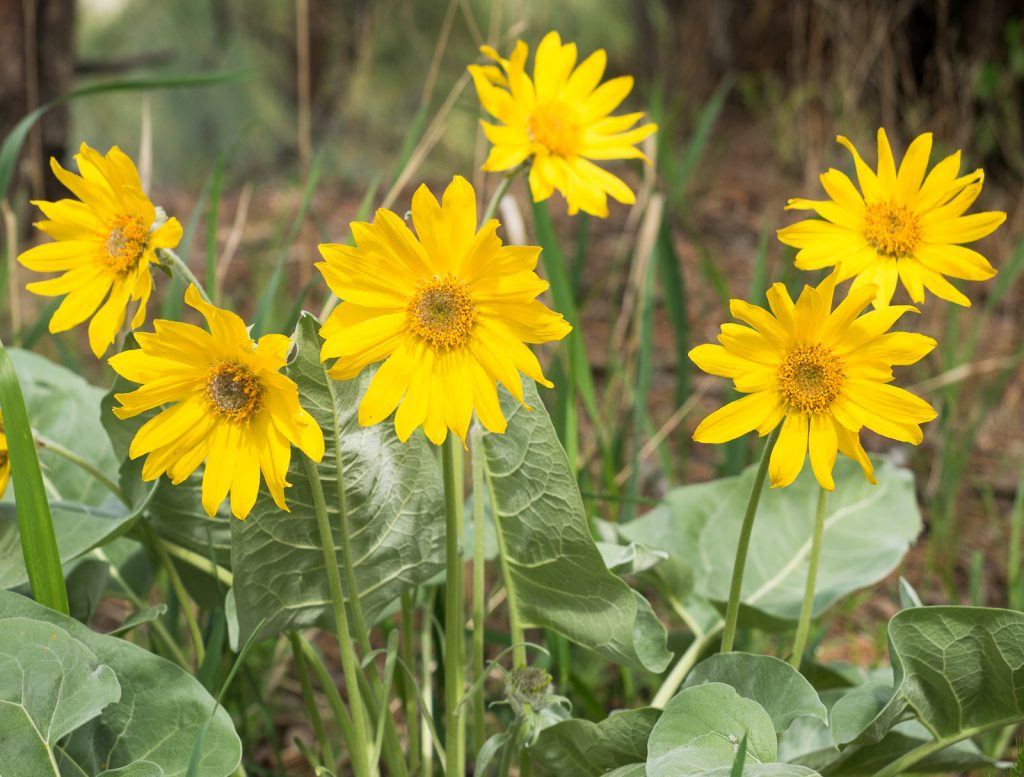
Spring officially starts on the spring equinox which falls on March 19, 20, or 21 in the northern hemisphere and September 22 or 23 in the southern hemisphere. On this special day the sun shines directly on the equator of our planet and for a short time day and night have almost the same number of hours. From that point on daytime starts getting longer than nighttime.
Spring is a wonderful season for outdoor activities and adventures for families with kids of all ages. Below I have listed 50+ activities that embrace the wonders of springtime with suggestion for younger and older kids alike. Don’t forget to find your inner child and join in on the fun!
Disclaimer: This page contains Amazon Affiliates links and I may earn a small commission from your purchases made through them.
Post updated: February 2024
Discover Signs of Spring Together
Spring is a time of great change. The world around us is exploding with new smells, colours and sounds. Every day in spring there is more to discover and see. This spring take time to slow down and enjoy spring with your child.
1. Search for signs of spring on a nature walk.
A spring nature walk is a fun way to discover signs of spring in your area. Click the link below for prompts, ideas and a free printable for helping your child discover signs of spring using all of their senses.
2. Discover the joy of watching birds.
Spring is an exciting time of year for bird watching. Around the beginning of March, birds are returning north from the their wintering home to build nests and gorge on a fresh supply of insects and nectar. Can you hear the call of the red-winged black bird? Or spot an American robin hunting for worms?
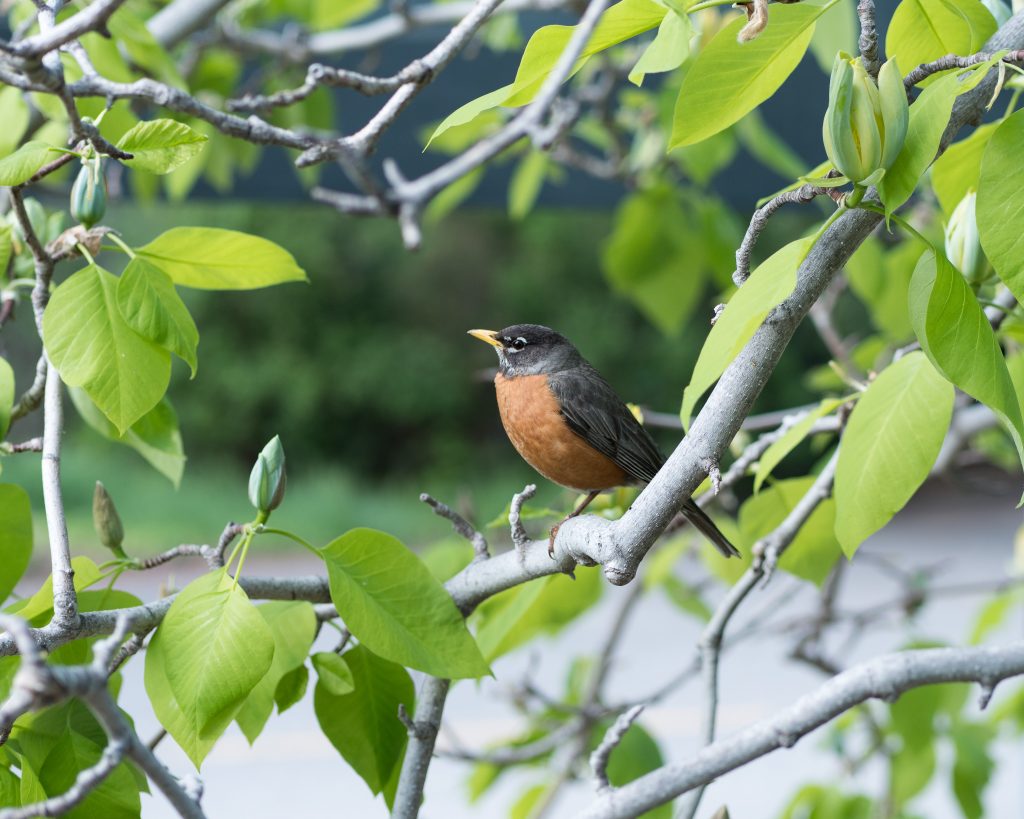
Bird Watching Tips for Kids
- Visit different places. Different birds like to live in different places. Ducks and seagulls like to live near water. Robins enjoy parks, gardens or backyards. Woodpeckers hang around trees and wooden telephone poles.
- Use your eyes and ears. If you can’t see any birds encourage your child to stop and listen. Follow the sounds to find birds.
- Try binoculars. Binoculars can help kids see birds close up. If you decide to buy binoculars, look for binoculars that are easy for kids to use. Look for binoculars that have a wide field of view (30 or 32 mm) with a lower zoom power (6 or 7x)).
- Set up a bird feeder. Bring the birds to you by setting up a birdfeeder near your home (and out of reach of neighbourhood cats!)
- Download a birding app like eBird and Merlin Bird ID.
- Participate in a bird count. Take part in the Audubon Great Backyard Bird Count.
- Read books about birds. There are so many good books about birds for kids. I’ve listed several below.
3. Raise caterpillars and release butterflies.
Metamorphosis is a unique life-cycle where a creature goes through two of more significant changes to reach adulthood. Butterflies are a perfect example. They start as tiny eggs, hatch into caterpillars, form into a chrysalis and hatch as a butterfly. Seeing all four stages in nature is very difficult. However, there is one way to see all four stages up close. Rear butterflies inside your home!
There are many companies that offer butterfly rearing kits. I like to order a painted lady butterfly rearing kits from here (in Canada).
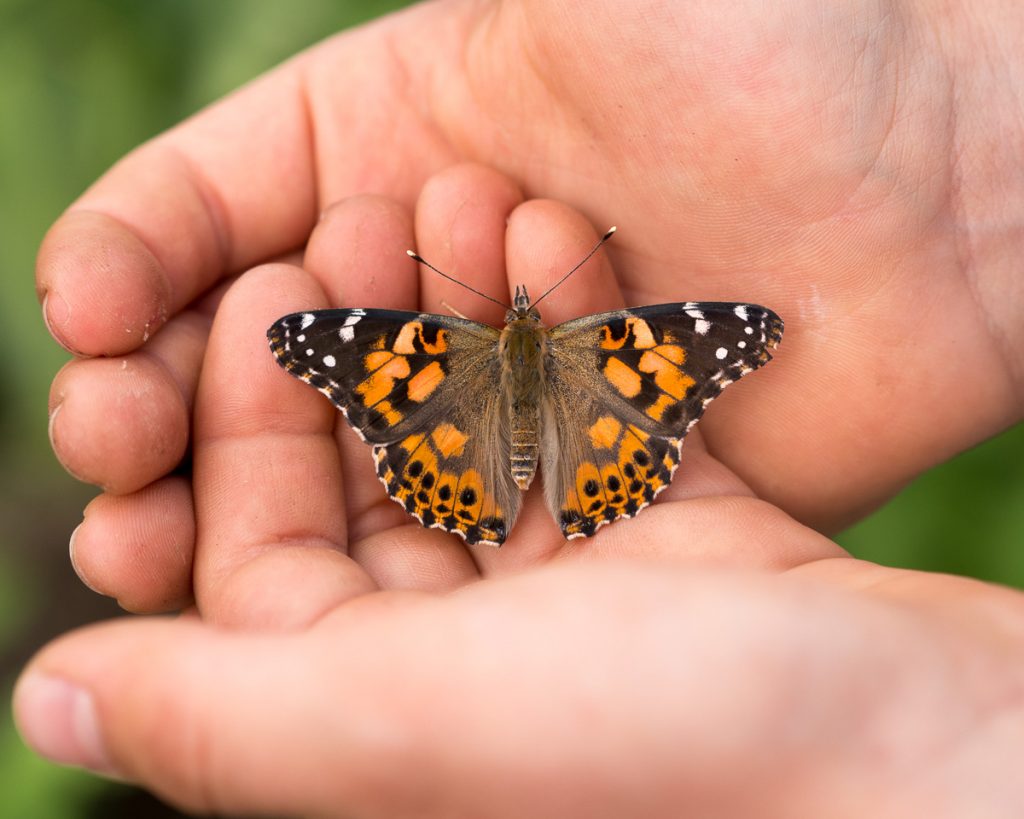
4. Explore the secret world of ponds.
At first glance, a pond might seem small and insignificant, but below its still surface there is a magical world waiting to be discovered. Pond dipping is a fun must-do nature adventure for kids. The great thing is that it’s so easy to do. All your child needs is a pond and a net (or a couple buckets). Dip the net into a pond and the fun has begun!
For more information about pond dipping with kids including a free Pond Minibeasts printable click the link below.
5. Dissect a fantastic flower.
Flowers are fantastic! They look pretty and smell wonderful. They also have a special superpower. Flower help plants reproduce. Dissecting a flower will help you and your child become more familiar with the special parts that make up flower. Here is a great flower dissection resource.

6. Adopt a special tree.
Every child should have a special tree. A tree to sit under. A tree to climb. A tree to gather from. If you or your child have a special tree, make regular visits to your tree through spring and see how it grows and changes. If you do not have a special tree now is the time to find one or plant one!
7. Go on an insect hunt.
Insects are everywhere! They are the most common animal on Earth and there are tons buzzing around by late spring. Going on an insect hunt is a fun way to introduce younger children to the world of invertebrates.
If you and your child are collecting insect in a place where there are ticks and mosquitoes it is wise to cover up with light coloured long pants, a long sleeved shirt and spray clothes with insect repellent.

8. Watch the clouds float by.
Spread a blanket on the ground and invite your child to watch the clouds float by. Encourage your younger child to find shapes and stories in the clouds. See if your older child can learn about the many different types of clouds that fill the sky (stratus, cirrus, nimbus) with this handy cloud identification guide.
9. Visit baby animals at a local farm or petting zoo.
Young or old, everyone loves baby animals. They are just too cute! Visiting a local farm or petting zoo is a fun way for your child to interact with spring baby animals and learn about animal life cycles.
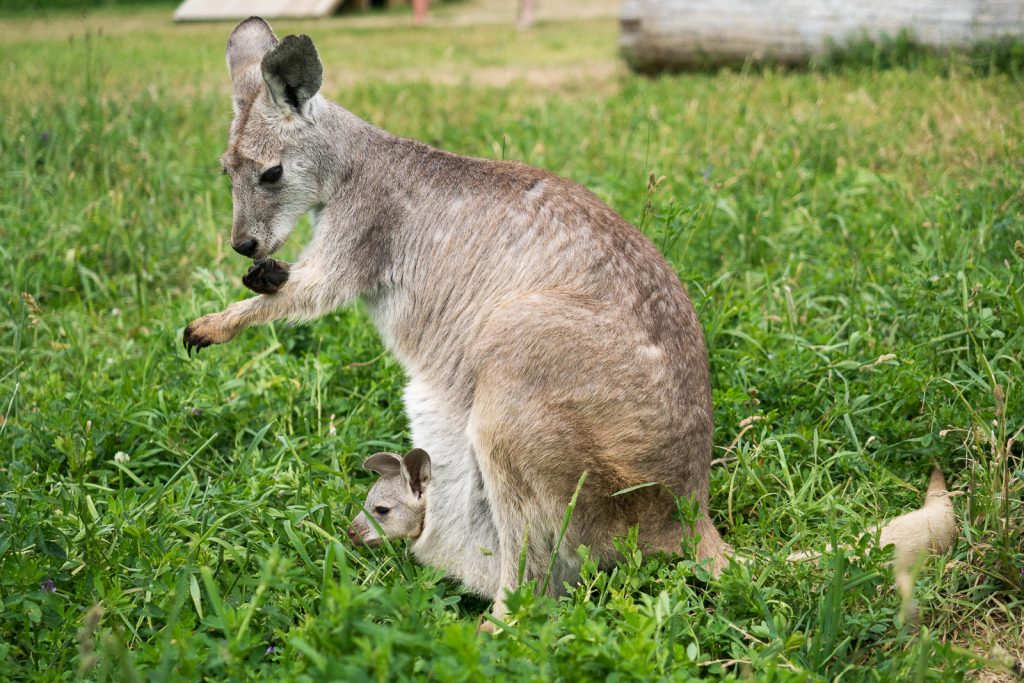
10. Find an amazing amphibian.
As snow melts and ponds fill, frogs and toads start calling. They are looking for a mate. Amphibians, like frogs and toads, are creatures that live in water and on land but most start their life in the water… so that would be a great place to find one! Encourage your child to follow the sounds of amphibians and see if you can spot one. Older kids might enjoy the challenge of building a frog pond in your yard.

11. Look up at the night sky and learn about spring constellations.
There are so many changes in spring. The days are getting longer, the night shorter and the sun feel warmer. The night sky is changing too. New constellations are filling the night sky. If you live in the northern hemisphere you might see the fair maiden Virgo and the fierce lion Leo.
Viewing the night sky with your child is a special opportunity for connection. Download a stargazing app on your phone or get a book from the library, bring some cozy blankets and find a dark place to observe the night sky.
12. Observe hardworking pollinators.
Plants need pollinators to reproduce. Without pollinators like honeybees, butterflies, ants and flies we would be in big trouble. A lot of tasty things we like to eat like apples, peaches, grapes and strawberries would not grow very well. Here are some ways you and your child can appreciate the humble bee:
- Learn more about pollinators by visiting a honeybee farm.
- Do a wild pollinator count (fun for older kids!)
- Build a mason bee hive.
- Plant bee friendly plants in your yard.

13. Record spring observations in a Spring Nature Journal for kids!
Wouldn’t it be perfect if there was a nature journal that your child could record all their spring discoveries? There is! I created a Spring Nature Journal that covers all the signs of spring listed above with plenty of room for your child to make notes and record their findings. You can purchase the ebook HERE (Payhip) or HERE (TpT).
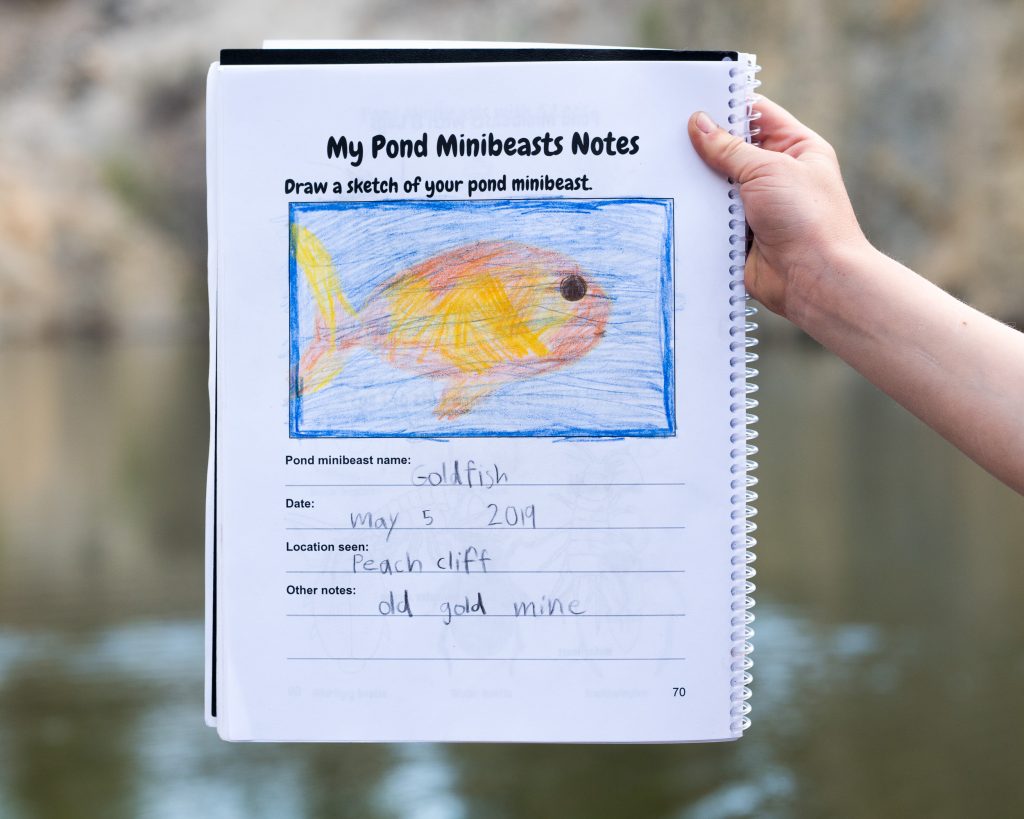
Get Those Hands Dirty!
Kids need to get dirty to be healthy and happy – a bold statement that has some serious scientific backing. Dirt isn’t dirty, it’s actually filled with all sorts of healthy microbes that can help strengthen a child’s immune system and help prevent chronic disease. Put away those wipes and say YES! to dirt with these fun springtime activities.
Children should be outside often and should be allowed to be barefoot and to get dirty, and handwashing does not necessarily need to immediately follow these activities. – Let Them Eat Dirt: How Microbes Can Make Your Child Healthier
14. Make mud pies.
All that’s needed for making a delicious mud pie is a bucket, stick, dirt and water. Mix, stir, pat and decorate with nature finds (rocks, leaves, flowers, shells). Scrounge up some old pie metal pans and measure cups from your kitchen or the local thrift store.
15. Dig into soil science.
Nobody is too old for mud pies, but if your older child wants to dig a little deeper try some soil science. Soil is made up of a mix of thing like minerals, organic matter, small rocks, fungi and bacteria.
Learn more about the soil near your home by filling three clear quart sized (1 L) containers with about a cup of soil from three different outdoor areas. Top the jars with clean water and let the soil settle for a few hours. Once the soil has settled have a look. What do you see? Why do you think this happened? Get curious!
16. Splash in a puddle.
“Yes! Jump in that puddle!” Your child will be so happy to hear you say those words. Even better, join them. Remember that shoes, boots and clothes can be washed and dried.
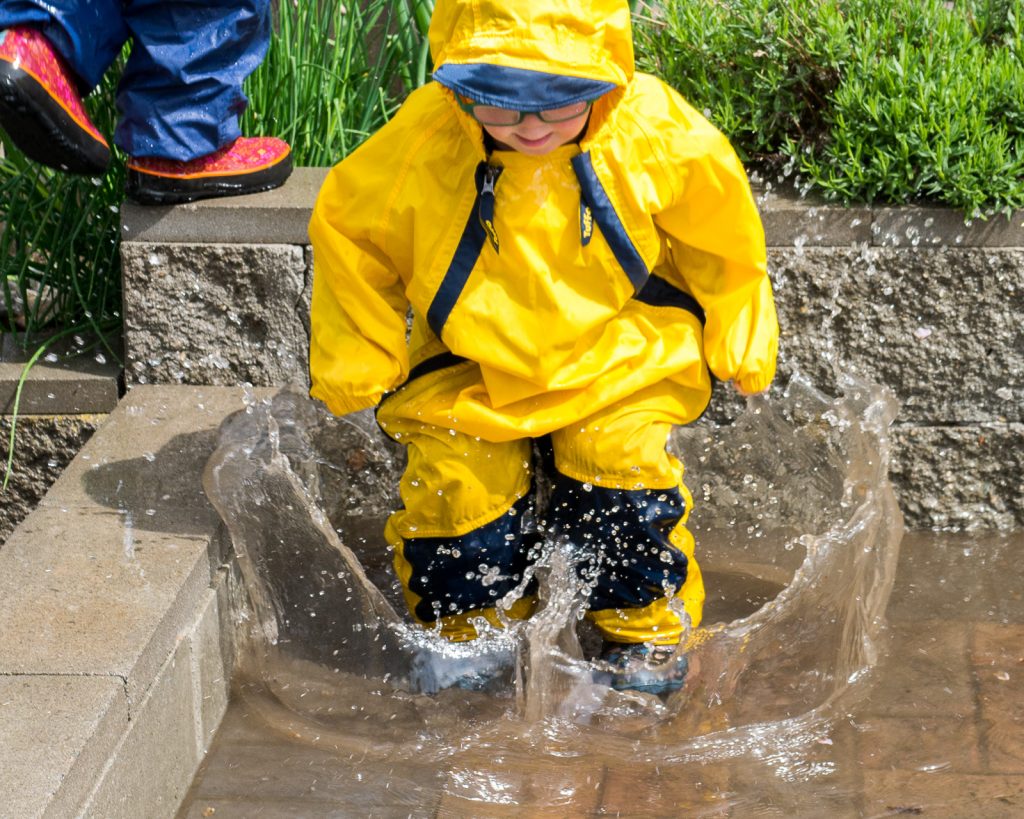
17. Catch wriggling earthworms after a rainstorm.
During spring rainstorms earthworm come slithering up from the ground. Unfortunately worms aren’t the smartest of creatures and they often don’t find their way back home… so next time the rain falls go out with your child and save those worms!
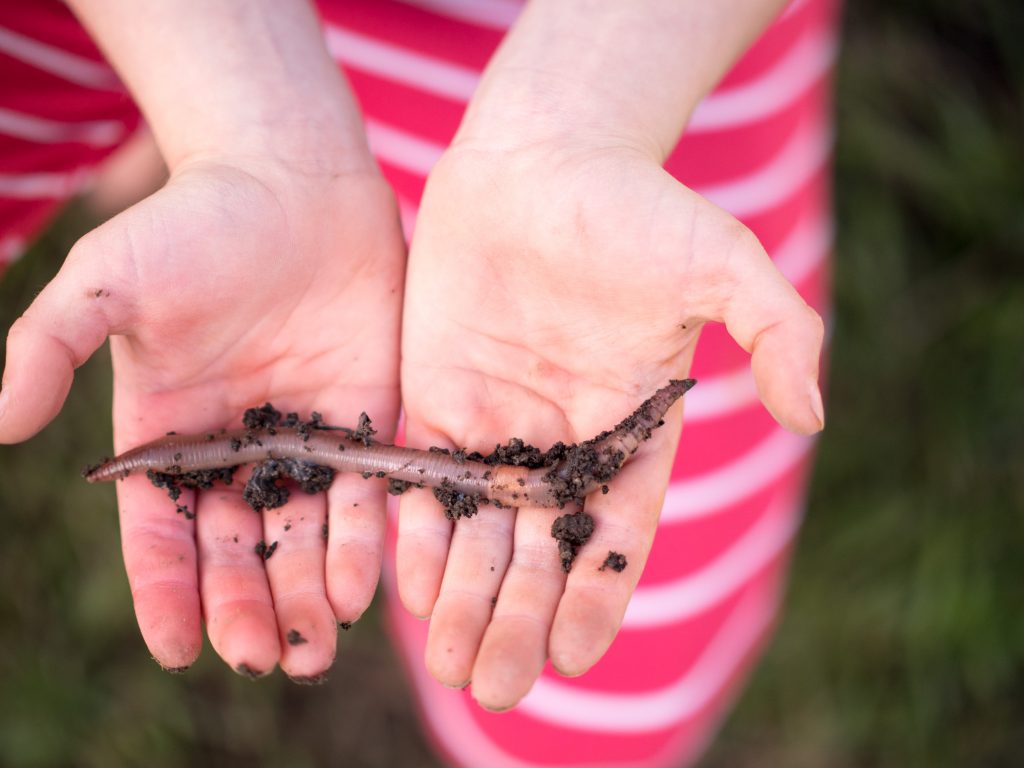
18. Start a vermicompost bin.
More worm fun! A Vermicompost is a compost that uses worms (vermi = worms) to break down organic waste into a dark rich fertilizer called worm casings (worm poop). It’s inexpensive, easy, eco-friendly, fun, non-stinky and a great learning opportunity for kids.
How to start a vermicompost bin:
- Find some vermicompost worms, called red wigglers from someone local. Check your local buy and sell or farmers’ market. Regular worms from the garden won’t work as well.
- Get an opaque storage tote with a lid (about 12″ tall or 10 gallon capacity – something like this)
- Drill some small holes in the bottom for drainage (no bigger than 1/4″ – like this).
- Drill a few holes near the top edge for air exchange.
- Tear up newspaper into strips, put them in water and squeeze them so they’re damp but not sopping. Put them in the bin.
- Add a handful or two of dirt into the bin.
- Place the worms into the bedding
- Feed worms vegetable and fruit scraps, coffee grounds, tea, dried leaves, crushed egg shells, cardboard and more newspaper.
- Place the bin somewhere indoors on something (an extra lid, a another bin) to catch any drainage.
19. Plant sleepy seeds and wake them up.
Whether you are a seasoned gardener or neophyte grower, watching a seedling burst forth into the world is simply magical no matter how old you are. If you and your child are new to starting seeds, I suggest growing bean, pea, or sunflower seeds because these seeds are bigger (easier to hold) and sprout quickly.
20. Create a fairy garden.
Step into the magical world of fairies by transforming a little spot of nature into a fairy garden. Resist the temptation to buy resin fairies and fragile fairy houses for your child! They’re pretty but they break easily.
Instead, invite your child to gather items from nature such as rocks, sticks, and shells to create their fairy garden. Try reusing and recycling items from around your home for props. If your child really wants to add something special to their fairy garden buy a couple small plants or an enchanted handcrafted wooden fairy door.
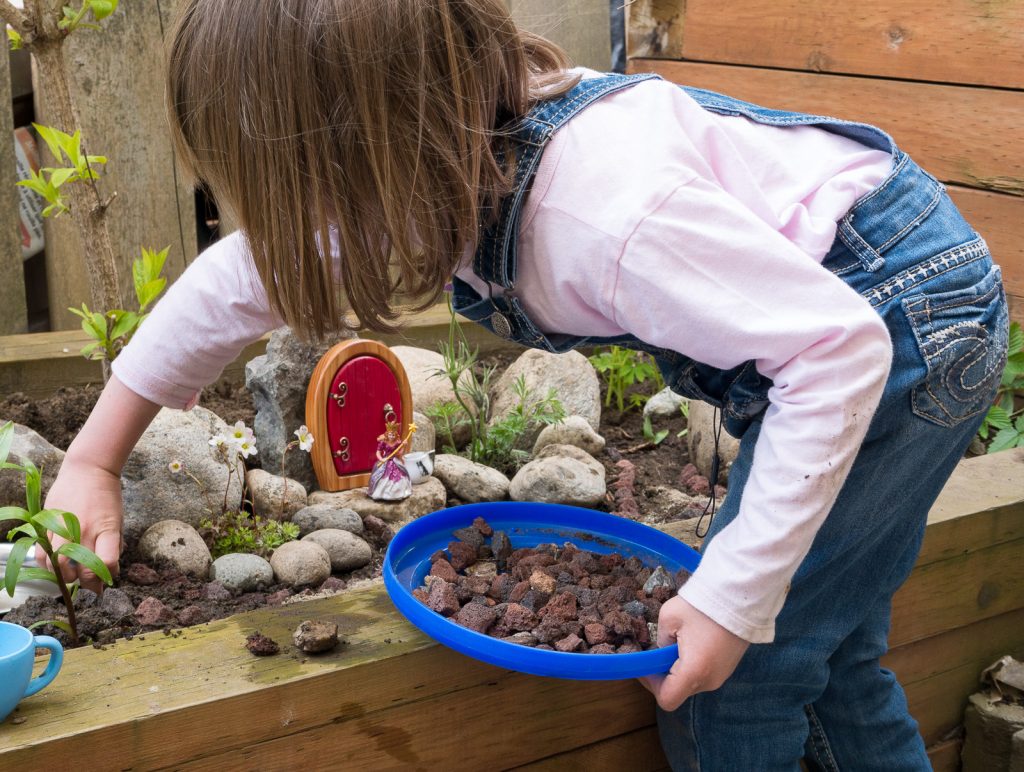
Fairies are invisible and inaudible like angels.
– Lynn Holland
But their magic sparkles in nature.
21. Paint with mud.
Humans have been using earth pigments to paint rocks walls for thousands of years so this activity should be natural for your little or big artist. No need to get fancy, all your child needs is mud, their hands and a place to lay on the mud. This activity is messy, and some kids like to do some body painting while they’re at it.
Older kids may want to try adding pigments to make colourful mud paint. Food colouring, powdered tempura or liquid watercolours work. Just be aware that the colouring may stain hands, clothes and any surfaces that the paint is applied to.
22. Pick ruby red strawberries.
One of the first springtime crops at our local u-pick is strawberries! My kids love picking organic strawberries at our local u-pick but I’m fairly certain it’s because more strawberries end up in their belly than their bucket. Thankfully our local u-pick farmer insists that my kids need to make sure the strawberries taste good.

23. Host a flower potting party.
Celebrate spring by hosting a flower potting party for your child and their friends. All you need is small pots, dirt and spring flowers to plant. Pansies are a great pick because they are so pretty and easy to care for.
24. Play in the rain.
There’s no such thing as bad weather, only unsuitable clothing.
– Alfred Wainwright.
Don’t let a little or a lot of rain damper your child’s adventurous spirit. Pull on raincoats, rain pants and boots and get wet! If your child is resistant to rainy day play here are some outdoor activities to try out:
- Give your child a container and ask them to collect raindrops.
- Use rain drops, paper and water colour paint to paint in the rain.
- Try to catch raindrops on your tongue.
- Jump in puddles!

25. Plant a butterfly garden.
Hop over to Run Wild My Child to read all about How to Plant a Butterfly Garden with Your Child to attract these beautiful pollinators into your yard.
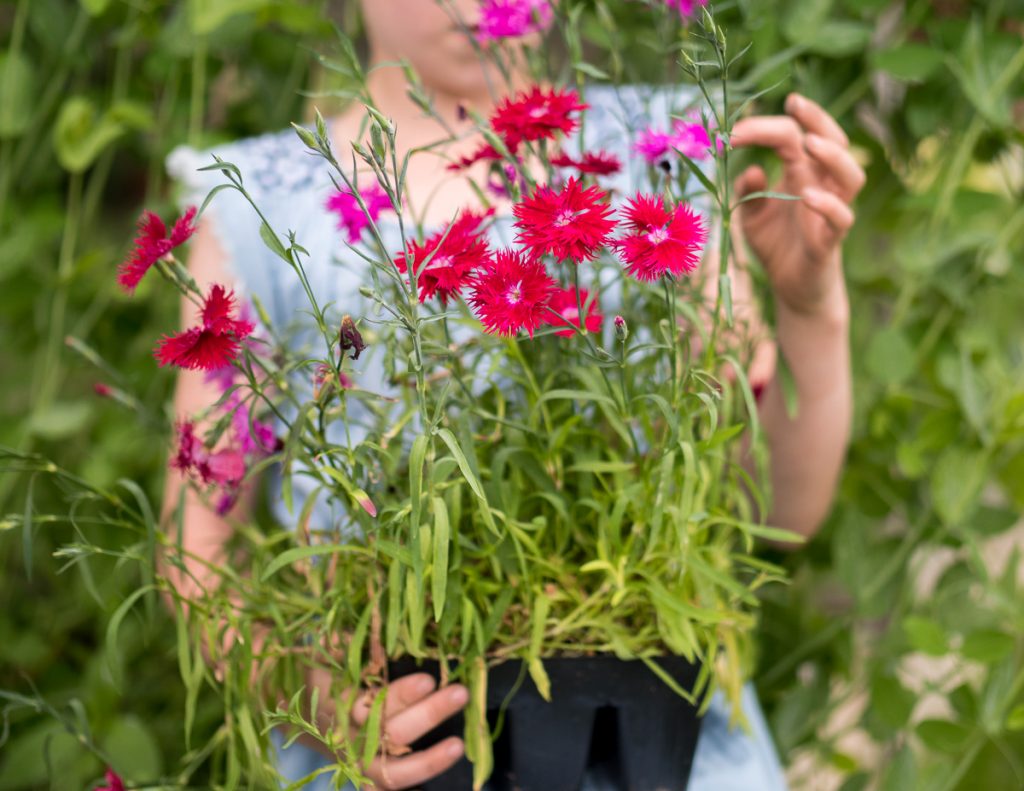
Make Spring Nature Crafts
Using nature for arts and crafts has two great benefits. First, it helps our children connect with nature in a very hands on way. Second, it is very eco-friendly. Projects can be easily composted and recycled. So instead of heading to the local craft supply store this spring, head out into nature instead.
26. Weave a flower crown.
Nature crowns are magical things. Weaving branches, flowers, leaves and little bits of nature into a crown, gives children a wonderful opportunity to connect with nature, develop fine motor skills and engage in imaginative outdoor play. For instructions and tips on making a willow nature crown click the link below.
27. Design a bird nest.
A nest is a masterpiece and Mother Natured has the cutest tutorial on making a bird nest using natural materials. This wonderful activity is great for older kids and for younger kids that have a helping hand.
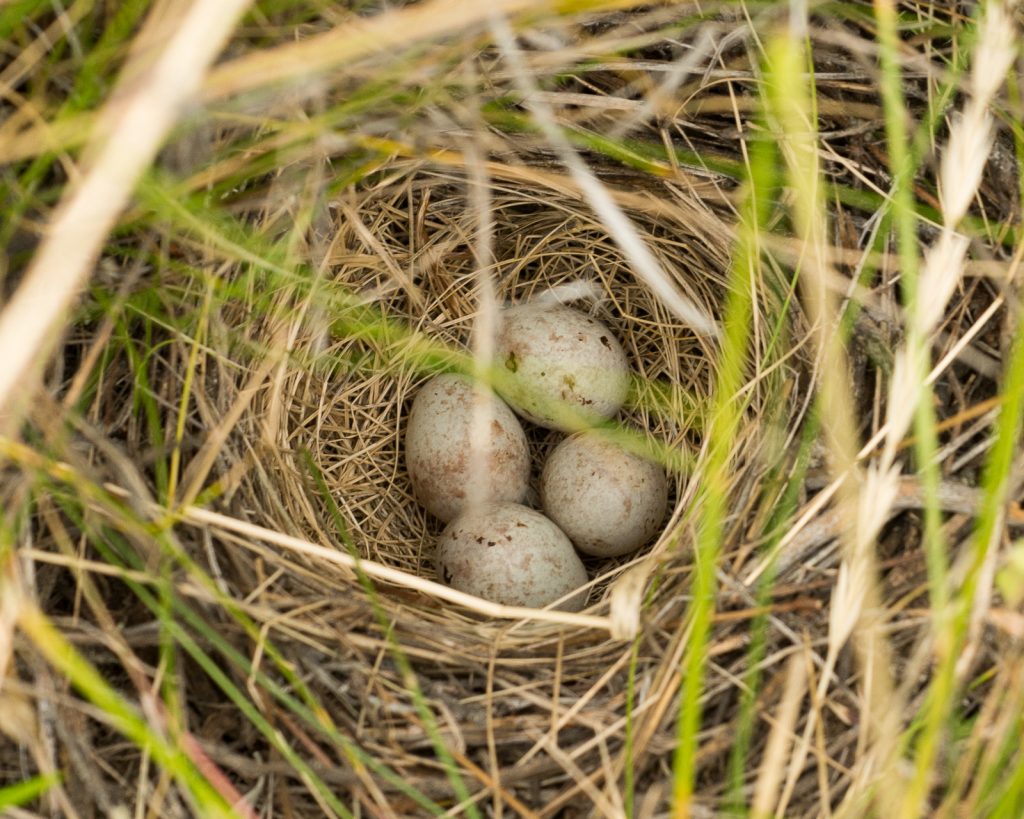
28. Practice nature threading and weaving.
Nature threading or weaving uses bits of nature to practice the art of weaving and sewing. Younger children can work on improving their fine motor skills while older kids can create unique piece of nature art. I’ve included some links below for inspiration:
- Nature Weaving Craft by Little Pine Learners
- Backyard Nature Weaving Frame by Mother Natured
- Nature Threading by Play, Teach, Repeat
29. Stamp flowers onto paper.
Flowers stamping is a unique way to capture the unique details of individual flowers. This activity also works well with other bits of nature like leaves, shells, pinecones etc.
Bring your child on a nature hunt and gather a few study blooms along with any other interesting bits of nature. Set up a stamping station (outside is best!) with white paper and tempura paint in shallow containers or ink pads. Show younger children how to dip the blooms into tempura paint or dab onto inkpads and press onto paper. Your child can transform their art into pretty cards, wrapping paper or bookmarks.
30. Concoct a flower petal potion.
Concocting the magical petal potions is one of my favourite childhood memories and Mother Natured has a great flower petal potions tutorial.
31. Arrange a bouquet of flowers.
Arranging flowers is practical life skill that teaches children many useful skills such as pouring, cutting, and placing. Rhythm of Play has a well written post on Flower Arranging Montessori Practical Life Activity for Kids if you want to learn more about how to help your child learn flower arranging.

32. Press and preserve flowers.
Pressing flowers is a wonderful way for children to preserve the beauty of spring. Flowers can be pressed in a flower press or between the pages of a heavy book lined with parchment paper. Flowers with flat blooms are definitely the easiest to press such as pansies and daisies. The most difficult part is the wait. Flowers need about two to three weeks to fully dry.
33. Make and disperse seed bombs.
Seed bombs (or balls) are made by combining seeds, clay and a bit of soil. Once the seed bombs have dried they can be dispersed into nature. Learn how to make heart shaped seed bombs to share with your friends and family.
34. Hammer flower prints.
Learning how to use a hammer is a great life skill for children and hammering flowers is unique activity that has surprising results. This activity is as simple as it sounds. All your child needs is flower blooms, paper towel, a real hammer and watercolour paper.
Flower prints work the best on watercolour paper because the flower pigments absorbs into the paper beautifully. Choose blooms with high pigment that lay flat. Pansies are my kids’ favourite pick. Place the bloom face down on the watercolour paper, cover it with paper towel and gently hammer the bloom in all directions.
35. Dye eggs with natural food colouring.
Dying eggs is a favourite activity for kids of all ages. Dying eggs with nature food colouring add a whole new dimension of learning. Purple cabbage turns eggs blue and red onions skins turn egg lavender! There are many great tutorials for making natural dyes for eggs and I listed a couple below.

36. Make biodegradable spring glitter.
Traditional glitter is made up of tiny bits of plastic. Unfortunately, these pretty bits of plastic are terrible for our environment, many find their way into our rivers, lakes and ocean and are mistake by marine life as food. If your child loves glitter there is still a way! Make some biodegradable glitter out of natural materials like flower petals and leave by using hole punch to make little “glitter” shapes.
37. Create a spring mandala.
A mandala is a geometric circle that represents the beauty of the universe. The practice of creating mandalas comes from Buddhism and Hinduism but today mandalas are found everywhere. My children love making mandalas with their nature finds. Sometimes they even make them in nature for others to find.
Making spring mandala can help you and your child slow down and look deeply at the beauty and bounty in nature. What to show off your sping mandalas? Share them with our Raising Outdoor Kids Community on Instagram by using the hashtag #raisingoutdoorkids.
38. Decorate a Påskris Tree.
In Sweden it’s popular tradition to decorate tree branches with colourful feathers and eggs. This tree is called a Påskris Tree or Easter Tree. Traditionally a Påskris Tree is made up of bare birch branches but pussy willow branches are a nice option too. Invite your child to use nature finds to decorate your tree.
Celebrate Spring Together
39. Celebrate the spring equinox!
The first official day of spring happens on the spring equinox, also called vernal equinox. In the Northern Hemisphere the spring equinox happens on March 19th, 20th or 21st and in the Southern Hemisphere on September 22nd or 3rd. There are many wonderful traditions for celebration the first day of spring with your family. For seven fun ideas check out the post below.
In 2020 the spring equinox happens on March 19th.
40. Go green on Saint Patrick’s day.
Saint Patrick is the patron saint of Ireland which is the reason we associate this fun celebration will all things green and Irish. Saint Patrick was a real person and he had some grande adventures. Patrick lived during the 5th century and at the age of sixteen he was captured and sold into slavery in Ireland. At the age of twenty he escaped only to return again as a Catholic priest to share the message of Christianity.
Here are some unique nature inspired Saint Patrick’s day activities:
- Go St. Patrick’s day nature hunt. Search for nature that is green and gold.
- Try out some lawn bowling.
- Make a Celtic maze our of rocks, sticks and other bits of nature.
Saint Patrick’s day is celebrated on March 17.

41. Get outside on Easter.
Easter is the most important celebration of the year for Christians. It is the celebration of Jesus’ resurrection from the dead. For many families Easter is a day of celebration and feasting with family and friends. To balance out all the sweets and food make time to burn some energy in the great outdoors.
- Set up an Easter egg hunt outside.
- Go on a flower hunt.
- Have an outdoor egg race.
- See an Easter parade.
In 2020, Easter Sunday is celebrated on April 12th.
42. Read picture books about spring.
There are many wonderful spring books for children of all ages. Below I have shared a list of our family’s favourite spring themed books.
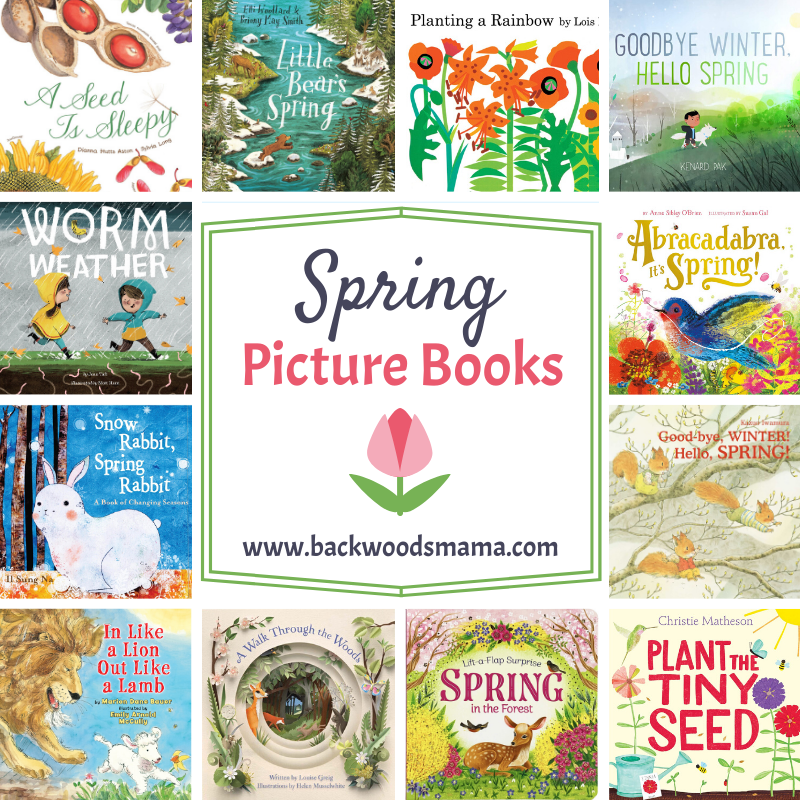
- A Seed Is Sleepy by Dianna Hutts Aston and Sylvia Long
- A Walk Through the Woods by Louise Greig
- Abracadabra, It’s Spring! (Seasonal Magic) by Anne Sibley O’Brien
- And Then It’s Spring by Julie Fogliano
- Goodbye Winter, Hello Spring by Kenard Pak
- Good-bye, Winter! Hello, Spring! by Kazuo Iwamura
- In Like a Lion, Out Like a Lamb by Marion Dane Bauer
- Little Bear’s Spring by Elli Woollard
- Make Way for Ducklings by Robert McCloskey
- Miss Rumphius by Barbara Cooney
- Plant the Tiny Seed by Christie Matheson
- Planting a Rainbow by Lois Ehlert
- Poppleton in Spring by Cynthia Rylant
- Spring by Gerda Muller
- Spring in the Forest by Rusty Finch
- Snow Rabbit, Spring Rabbit: A Book of Changing Seasons by Il Sung Na
- The Complete Book of the Flower Fairies by Cicely Mary Barker
- The Curious Garden by Peter Brown
- The Gardener by Sarah Stewart
- The Honeybee by Kirsten Hall
- The Reason for a Flower: A Book About Flowers, Pollen, and Seeds by Ruth Heller
- The Spring Equinox by Ellen Jackson
- The Sun Egg by Elsa Beskow
- Worm Weather by Jean Taft and Matt Hunt
43. Visit a farmers’ market.
There is nothing more tasty than freshly grown fruits and veggies from your local farmers’ market. Visiting is farmers’ market can be a special experience for kids.
- Meet your farmers! Talk to your local farmers and ask lots of questions. Farmers’ take great pride in their work and are always happy to share their knowledge with people of all ages.
- Give your child a say in what produce you purchase.
- Try something new. Has your child tried purple carrots, orange tomatoes, or yellow raspberries?
- Buy some seedlings to start your own mini-farm at home. Seedling are a popular farmers’ market item in the early spring.
- Make a special meal or treat with your child from your farmers’ market purchase.
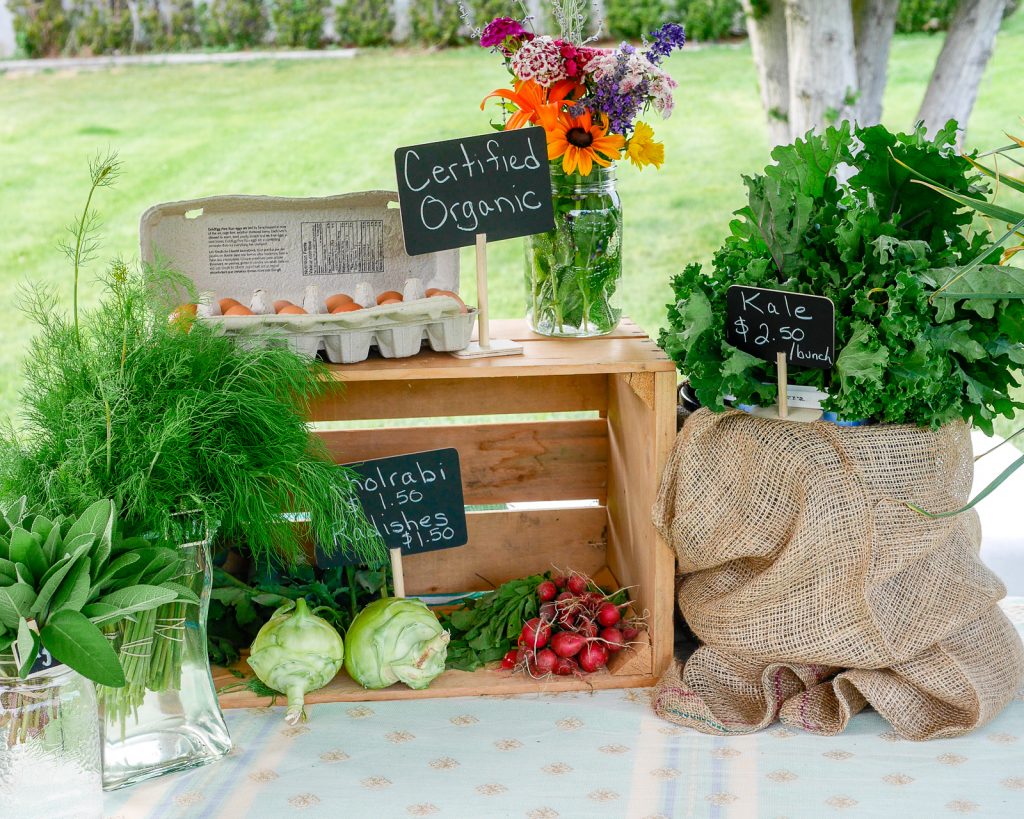
44. Make a pledge on Earth Day.
The first Earth Day was on April 22, 1970 and today it is an international celebration! There are many fun things your child can do to celebrate the beautiful planet we live on:
- Plant a tree or some flowers.
- Set up a birdfeeder and feed the birds.
- Make a family Earth Day pledge.
Earth Day is celebrated on April 22nd.
45. Drop by a garden centre.
Bring your child to a local garden centre and admire all the flowers! Many garden centres even have affordable (often free) workshops kids so be sure to ask when you visit.

46. Dance around a May Pole.
May Day is a wonderful springtime celebration that takes place on May 1st. This special day has its roots in ancient history. A very long time ago the ancient Greeks celebrated the Festival of Chloris and the Romans celebrated Floralia. Both of these festivals were in honour of the goddess of flowers. Over time these springtime festivals have evolved into the May Day celebrations that take place around the world today.
May day is celebrated on May 1st.

47. Enjoy a maple syrup festival.
Made from the sap of maple trees, maple syrup is delicious on pretty much anything. If your family is lucky to live near forests of maples then going to a spring maple syrup festival is a must!
Spring Maple syrup festivals typically happen in April.
48. Plan a spring picnic.
Enjoy a picnic in the great outdoors. Food always seems to taste better outside. Invite friends to come along!

49. Attend a flower festival.
Flower festivals take place across the world. There are cherry blossom festivals, tulip festivals, flower parades and flower carpets! Find a flower festival near you and go and smell the flowers.
50. Have a spring time feast.
Invite family and friends and share a spring time feast. Involve you child in choosing what to cook and bake. Make a menu together, shop together, cook together and feast together!
Gab your FREE printable PDF: SPRING NATURE ACTIVITIES FOR KIDS OF ALL AGES
